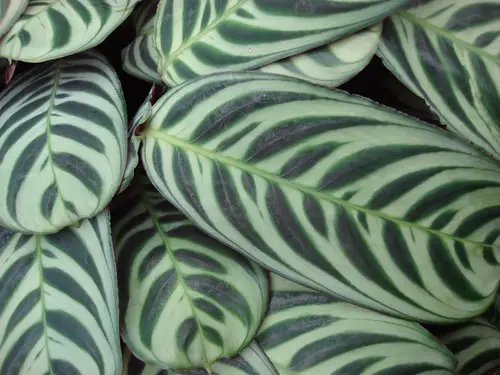The Prayer Plant, with its strikingly patterned leaves and unique daily movement, stands out as one of the most intriguing indoor plants. The name “Prayer Plant” refers to several species, particularly within the Maranta genus, and comes from the nightly habit of the plant to fold its leaves together, resembling hands in prayer.
Native to the tropical rainforests of Central and South America, the Prayer Plant enjoys warm, humid conditions. Its captivating leaf patterns and colors range from dark green with red veins to deep purples, creating an engaging visual display. Known for their adaptability, Prayer Plants can be a stunning addition to a home or office space.
Though attractive and charming, Prayer Plants require careful attention to detail in their care. Specific requirements for light, water, and soil must be met to maintain the plant’s health and vibrancy. Understanding the unique characteristics of the Prayer Plant is key to fostering its growth and enjoying its beauty.
| Aspect | Details |
|---|---|
| Common Names | Prayer Plant, Maranta Plant |
| Botanical Name | Maranta leuconeura |
| Family | Marantaceae |
| Plant Type | Perennial |
| Mature Size | Up to 12 inches tall |
| Sun Exposure | Indirect Light |
| Soil Type | Well-drained, Peat-based |
| Hardiness Zones | 11-12 |
| Native Area | Central and South America |
Prayer Plant Care
Caring for a Prayer Plant can be both a rewarding and challenging experience. Its unique light and water needs require constant attention, but with proper care, the Prayer Plant can thrive.
Providing the right environment is key to the Prayer Plant’s success. The plant does not tolerate drastic changes in temperature or humidity and requires a stable and controlled environment. Regular monitoring and adjustments can result in a healthy and flourishing Prayer Plant.
Light Requirement for Prayer Plant
The Prayer Plant prefers bright, indirect sunlight. Direct sunlight can scorch the leaves, leading to discoloration and damage. A location near an east or north-facing window is often ideal, or a shaded spot by a brighter window.
Soil Requirements for Prayer Plant
A well-draining, peat-based potting mix is best for the Prayer Plant. The soil should retain some moisture without becoming waterlogged, as this can lead to root rot.
Water Requirements for Prayer Plant
Watering is crucial for the Prayer Plant. It prefers consistently moist soil but does not like to be drenched. Water when the top inch of soil feels dry, and ensure good drainage to prevent standing water.
Temperature and Humidity
The Prayer Plant thrives in temperatures between 65-75°F (18-24°C). Humidity levels should be kept high, and this can be achieved with a humidifier or by placing a tray of water near the plant.
Fertilizer
Use a balanced liquid fertilizer every two weeks during the growing season. Reduce feeding in the winter months and follow the instructions on the fertilizer packaging.
Pruning Prayer Plant
Pruning can help to maintain the shape and size of the Prayer Plant. Regular removal of dead or yellowing leaves and occasional trimming of overgrown stems will enhance the appearance of the plant.
Propagating Prayer Plant
Propagation is typically done through division or cuttings. The plant can be divided during repotting, or stem cuttings can be placed in water or soil to root.
How To Grow Prayer Plant From Seed
Growing a Prayer Plant from seed is rare and can be challenging. If attempting this method, seeds should be sown in a warm, humid environment and kept moist.
Common Pests & Plant Diseases
Spider Mites
Wipe the leaves with soapy water or use an insecticidal soap.
Aphids
Use a mild insecticide or neem oil to control the infestation.
Common Problems With Prayer Plant
Leaf Curling
Caused by under-watering. Increase watering and monitor the soil moisture.
Yellow Leaves
Often a sign of over-watering. Adjust watering and check for proper drainage.
Brown Tips
Usually due to low humidity. Increase humidity levels around the plant.
Pro Tips
- Keep the Prayer Plant away from drafts and sudden temperature changes.
- Use filtered or distilled water to avoid fluoride, which can cause leaf discoloration.
- Rotate the plant regularly to ensure even growth and exposure to light.
- Be patient with the Prayer Plant, as it may take time to adjust to new conditions.
- Consider placing the Prayer Plant in a bathroom with natural light, where it can enjoy higher humidity levels.




